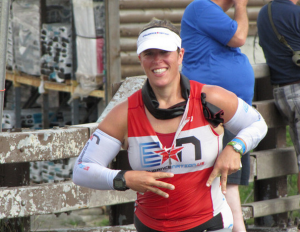Triathlon is a lifestyle and training is a huge part of who you are. You get up early, workout at lunch, and have training equipment in your car. You were recently voted “most likely to not go out because of a morning workout” by your hilarious colleagues. You debate lane etiquette on Twitter and have an impressive display of destination / athletic / witty bumper stickers. You are…a triathlete.
But while all this training constitutes 95% of the journey, we train because we race. We don’t judge our year by how well that Open Water Swim went on July 9th, rather we remember our races as the place in which we put our fitness to the test and earned a result.
There’s just one problem: Race Day Is About Execution, Not Fitness
Unfortunately a great race is made up of a ton of different elements, the intersection of which is the ultimate performance. And while training is important, it’s not the only arbiter of a good race.
If you are on the quest for that elusive outstanding performance, here are Endurance Nation’s Top Ten Reasons (in no particular order) why you are most likely undermining your own ability to perform at your peak!
1. You Race Too Much
I am always at just how much the average triathlete competes. And it’s not just in triathlons! Fall is filled with long-distance running relays and marathons. Winter is filled with running or winter events like XC skiing, skate skiing, or snowshoeing. Spring time brings the eternal quest for a Boston Marathon slot, not to mention any number of early-season cycling races.
And amidst all of this other noise, you are trying to become a competitive triathlete. Done correctly, a season full of different events can make you stronger. Since so many of us choose races for social reasons is that of competitive ones, we are often our own worst enemy. There is simply no way you can be your best in August if you have been racing hard every month since January.
2. You Don’t Prioritize Events
An overflowing race schedule isn’t always the worst thing. In fact, it might be only thing that’s keeping you sane. The real culprit isn’t the volume of races, but rather the fact that there is no prioritization.
It’s totally fine to race eight times between January 1 and March 31. Just make sure that one of those events is your key race, which you intend to taper and target. Focusing on that event will enable you to choose how hard you need to train as well as how hard you can race at all of the other events. In fact, it will let you know whether not you should do those other events at all.
Learning to sacrifice the immediate for long-term gain, building an effective season, is a skilled discipline.
3. You Start Too Early
If your key races in August there is no reason why you should be racing hard in January. Every season has the progression, regardless of what coaching philosophy you subscribe to. Whichever one you choose, make sure that you understand the fundamentals of how your fitness will be built and your responsibilities in regards scheduling events.
One of the consequences of participating in such a popular sport is the fact that many events sell out long before race day. Registering early is a requirement, not an option. This early action also brings with it much anxiety, putting beginner athletes in a place where their head is already focused on the next race that is 365 days a way you
Training this long for an event that far away is a recipe for mental and physical breakdown. Do yourself a favor and pick intermediary events that will allow you to build your fitness and maintain your focus, never losing sight of your overall goal for the season.
4. You Don’t Know How To Taper
Training is easy, tapering is hard. Training is something we do every day, some of you several times a day. Tapering is something very few of us do. In fact, most triathletes spend the bulk of their seasons training straight through races using them as organized workouts.
When it comes to actually tapering for performance you most likely don’t have enough data to know what will work for you. Remember that the goal of tapering is to have the 100% rested for race day. That’s rested, not ready. Because rested is ready.
I’ve heard more than my fair share of stories from athletes who need it to do just one more key workout to make sure they were ready, in that workout was, in fact, their race. This made the big event into nothing more than a footnote… Instead of a foot race.
Resting is easy. The best way to do it, simply not worked out. But most Type A triathletes don’t come with an off switch, and if they do their version of “off” isn’t exactly what their body needs. Remember that no one ever said they were too rested on race day. Building the right taper takes practice and even some tweaking along the way.
5. You Swim Too Hard On Race Day
Then again, it’s possible to get everything right and still not have your best possible race. Your equipment is good, your fitness is high, you are mentally ready… But then you go out and try and impersonate Michael Phelps on race day.
Sometimes this is caused by an experience, sometimes simply by too much adrenaline. Either way, your body simply can’t handle the work of a super hard swim within the context of the triathlon.
It’s worth spending a few key workouts before your next a race focusing explicitly on to race pace swimming. Not to get faster, but rather to dial in that case so that it becomes the default. While the vast majority of triathlons aren’t won on the swim, many of them are lost there.
6. You Can’t Hit Race Weight
Fitness is one thing, speed is another. While there are many different gradations when it comes to quality of equipment — usually in proportion to how much you’re willing to spend on it — there are some things that money can help us avoid. The biggest one on the list: gravity.
Aside from the time you spend in the water, the rest of your time is spent moving your body across land. In the larger you are, the more work you have to do. The math is that simple. You are far better off working to lose 5 pounds then you are to spend hundreds if not thousands of dollars on a wheel set that will save you 1000 g you are better off losing 5 pounds then you are locking yourself on your bike trainer for 8 weeks to improve your threshold power.
Weight loss is and, of course, extremely relative. Some of us have more to lose than others. Know your body, know your limits, and focus on the things that give you the highest return on investment. Besides, looking really fit and strong on race day is a secret psychological advantage.
7. You Frequently Change Your Training Focus
As a coach, this has to be one of my biggest pet peeves. Back in the day, there was very little information on coaching, workouts, or training performance. Now thanks to your smart phone, you’re only seconds away from finding hundreds if not thousands of articles with training ideas and to us. Each one promising better results than the last.
While you might be worried about your child’s potential for having Attention Deficit Disorder, many of you suffer from a parallel issue: Training Attention Deficit Disorder.
What starts out as a simple season with the master plan quickly the balls into doing the workouts your friends are doing. Maybe you find a new article on secret high intensity intervals, and now you’re including those as well. Adding hill to your new training focus. running? Not a problem…that’s in the schedule now too. Everyone is doing a big century ride this weekend, so you cut your intervals and do something else instead.
While there is always new information on what can be more effective, there is no substitute for a consistently implemented program. It usually takes your body anywhere from 6 to 8 weeks to achieve a basic training plateau. Any changes, incremental or otherwise, made during the six-week period will inhibit your bodies ability to adapt and grow.
Next time you find something new and appealing, set it aside for when you revisit your training results within the context of your master season plan at the end of one of these phases.
8. You Ignore Your Seasonal / Life Constraints
Regardless of where you live, your athletic world has a season. As a time when getting outside to train is feasible and that is the time when training indoors is deftly recommended. There’s a time and a place for both within the context of improving your fitness. Recognizing this pattern and using it to your advantage can be an incredibly effective way of boosting your fitness for the long-term.
Ignore these basic truths about your climate zone or the nature of your job (accountants should never race in March or April!) at your own peril. Every year I hear stories of people trying to accomplish six-hour ride from the trainer because they sign up for an early season race even though they live in New England.
On the flip side, I also hear the grumbling from people who’ve signed up for a late-season race in November or even December long after their friends have stopped training and things have ceased being fun.
One of the most important things you can do is identify this rhythm and build your season around. This will reduce friction both at home and it worked, and allow you to build your fitness to peak when it matters –- and when your body is ready.
9. You Don’t Recover Well Enough
One of the more amazing things about triathletes is the sheer amount of work and stress they can handle. From work 2 home 2 social commitments to volunteer opportunities to training and racing, the list of things to do it is both impressive and intimidating. While it’s easy to get caught up in the game of doing more, success in our sport is actually a function of doing things well.
The shift from “more” to “better” has to do with one simple thing: absorption. Anyone can fire up an insane 6 x 1 mile repeat workout after a century ride. The difference between you and someone like Craig Alexander is that he can absorb that work and grow off of it. You and I? We’re lucky if we simply survive, spending the next 3 to 5 days trying to recover.
The most important thing you can do for recovery is to get enough sleep every night. At a minimum you should target an average of 7 hours a day across a week. If you can get 8 hours a night, that’s even better. You’ll want to follow a consistent schedule (see number 7 above) so that you have adequate time between key sessions each week.
Do your best to avoid overreaching in any individual workout, remember our goal is to be consistent instead of flashy. If you can feel the signs of fatigue setting in, whether it’s in the context of your daily life or work out, take the time to dial things back. It’s always better to rest a day now because it’s good for you then wait until you have a problem and you have no other choice but to try and fix it.
10. You Don’t Have A Baseline Execution Plan
While this might not be the most important success factor for peaking, it is a critical part of achieving your best. I’m constantly amazed at the sheer number of triathletes who choose to wing it on race day with no plan.
From my experience, the exact opposite would be more effective: minimal fitness but a fantastic race plan. The longer your “A” race of choice, the more relevant this becomes.
What allows you to do this test your plan against the reality of race, and then learn from what happened. Without a plan, you are arbitrarily applying your fitness and resources to the race. Even though that might work, this minimal opportunity for growth because you have nothing against which to compare your outcomes.
Having a specific plan allows you to incrementally improve it between races until you reach a place where racing itself is more of a habit than an event.





Joe Hallatschek
This was excellent! The ability to improve is directly related to the ability of the body to absorb the training. i got it – good to hear this reinforcement!